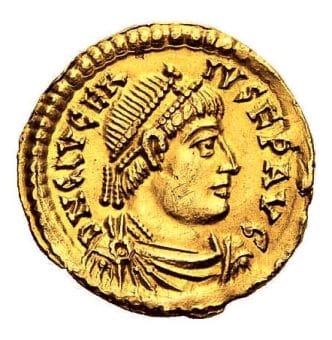Last Updated on December 25, 2021 by Vladimir Vulic
Life: AD ? – After 480?

- Became emperor March AD 473.
- Deposed by Julius Nepos AD 474.
Following the death of Olybrius there was a period of about four months during which there was no emperor in the west, sole rule therefore falling to Leo, emperor of the east.
Leo struggled to find a suitable candidate. Hence in AD 473 Gundobad, who held the powerful position of ‘Master of the Soldiers’ in Italy, simply appointed an emperor himself.
Naturally Gundobad chose one of his own military men, namely Glycerius, who was the commander of the imperial bodyguard (comes domesticorum).
In March AD 473 he was proclaimed emperor in Ravenna.
Meanwhile the Ostrogoths were on the move in the Danube region and showed intent on moving into Italy.
Glycerius though managed to persuade them by use of diplomacy rather than force, to move into Gaul instead.
But now Leo, unwilling to accept Glycerius whom he saw as a usurper on the western throne, sent forward Julius Nepos with a fleet in order to overthrow him. Nepos landed at Portus Augusti and there, as agreed with Leo, declared himself western emperor.
At the key moment when Glycerius needed his powerful ‘Master of Soldiers’, Gundobad left Italy. Had Gundobad’s two brothers died, he had become his father’s sole heir to the kingdom of Burgundy.
With Gundobad gone, and no other obvious support, Glycerius simply surrendered to Julius Nepos without a fight.
He resigned his title and instead accepted the ordination as bishop of Salonae (Solin) in Dalmatia.
Accounts on his later life are mixed, some claiming that he died before he could even begin his new role as bishop.
Though one intriguing account (by the historian Malchus) claims that Glycerius indeed did become bishop of Salonae, indeed he even went on to become archbishop of Mediolanum (Milan) from where he in AD 480 then masterminded the assassination of Julius Nepos.

Historian Franco Cavazzi dedicated hundreds of hours of his life to creating this website, roman-empire.net as a trove of educational material on this fascinating period of history. His work has been cited in a number of textbooks on the Roman Empire and mentioned on numerous publications such as the New York Times, PBS, The Guardian, and many more.
